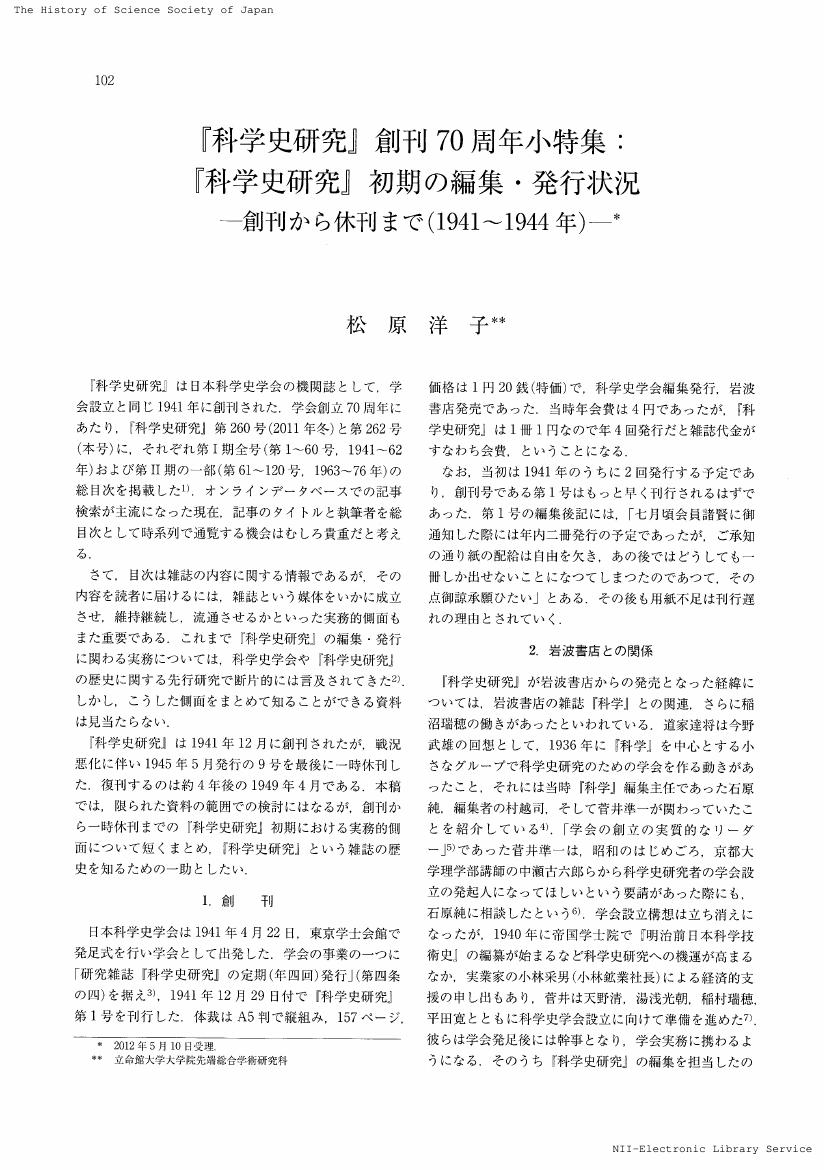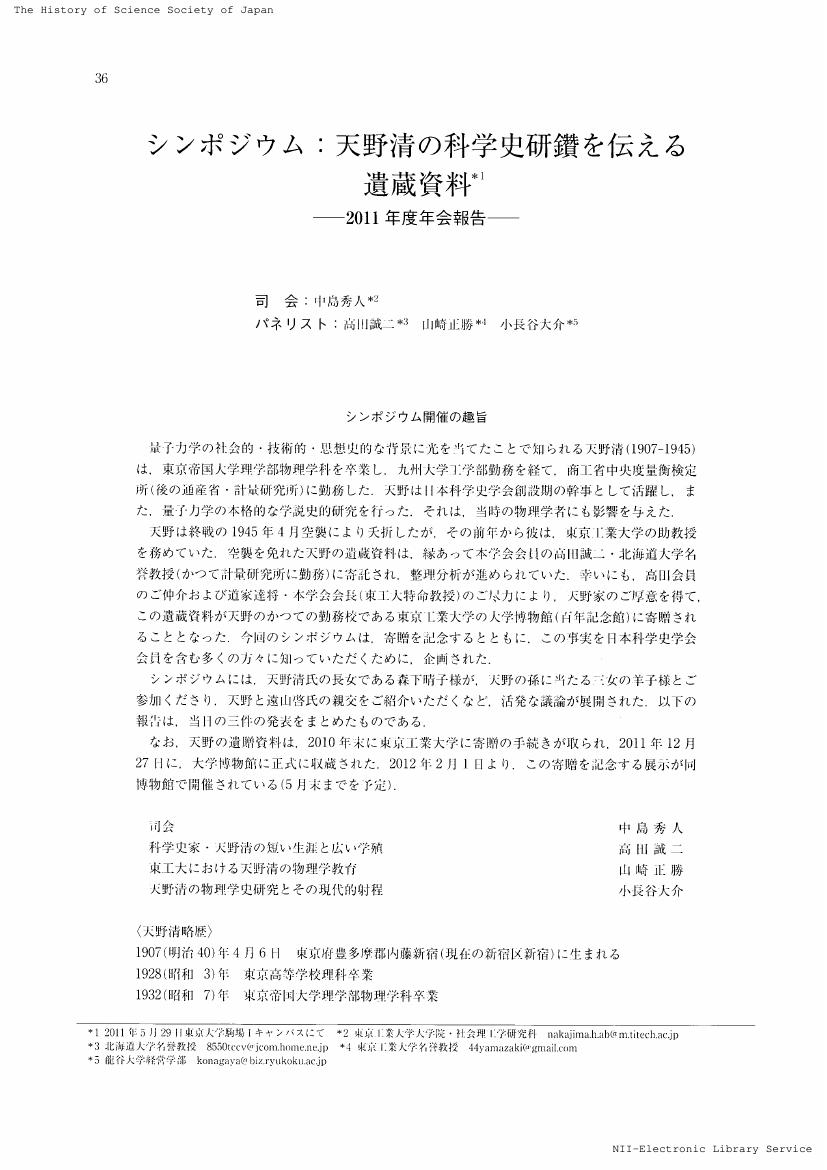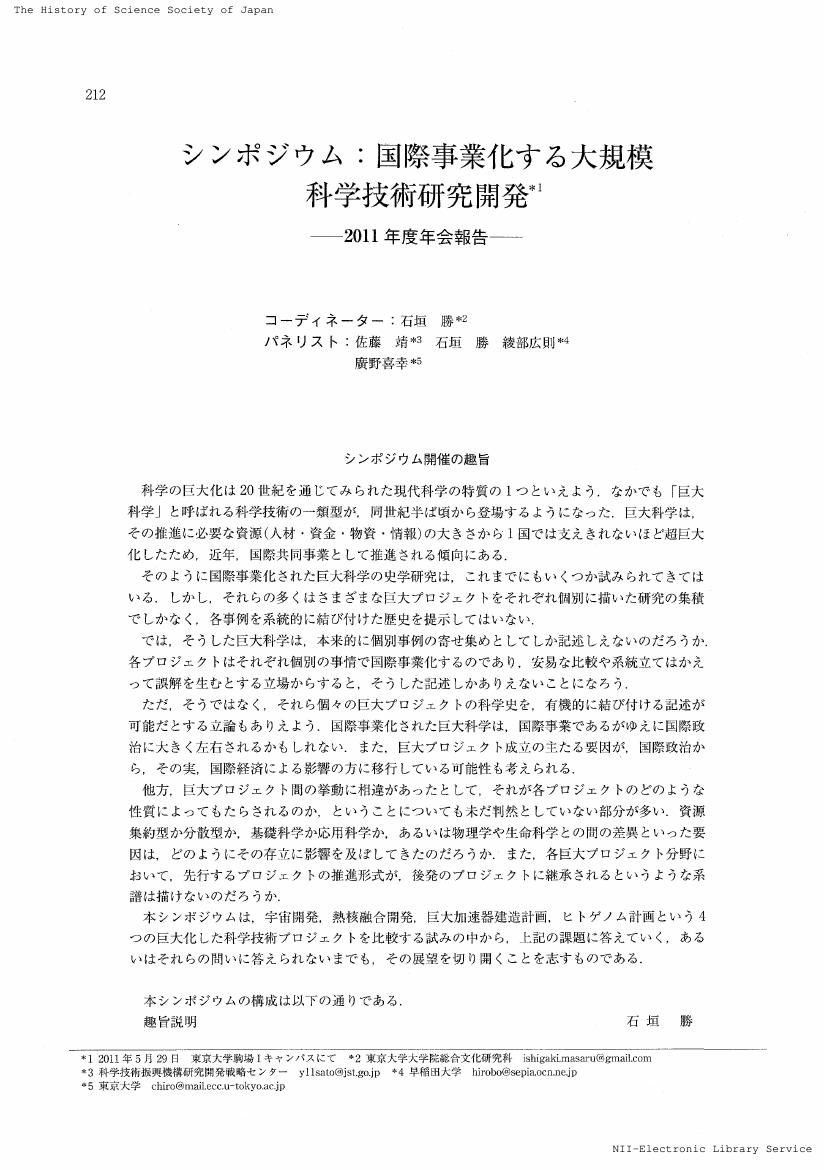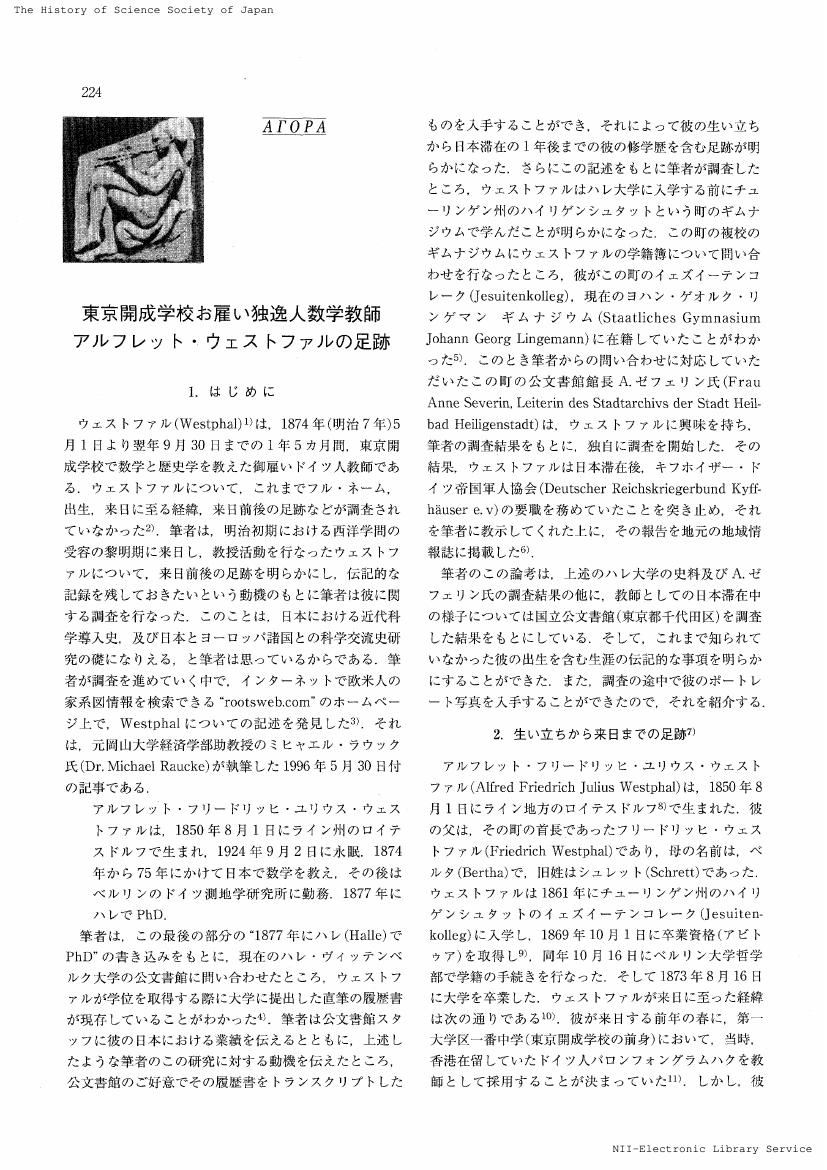- 著者
- 石山 洋
- 出版者
- 日本科学史学会
- 雑誌
- 科学史研究 (ISSN:21887535)
- 巻号頁・発行日
- vol.51, no.262, pp.95-101, 2012 (Released:2021-07-20)
- 著者
- 松原 洋子
- 出版者
- 日本科学史学会
- 雑誌
- 科学史研究 (ISSN:21887535)
- 巻号頁・発行日
- vol.51, no.262, pp.102-105, 2012 (Released:2021-07-20)
1 0 0 0 OA イブン・シーナーの自然精気
- 著者
- 矢口 直英
- 出版者
- 日本科学史学会
- 雑誌
- 科学史研究 (ISSN:21887535)
- 巻号頁・発行日
- vol.51, no.263, pp.129-137, 2012 (Released:2021-07-20)
It is often stated that physicians in medieval Islam followed Galen in assuming that there were three kinds of pneumata (psychic, vital and natural) in human beings. This article examines the concept of the third kind of pneuma, the natural pneuma (ruh tabi i), in the medical theory of Ibn Sina (d. 1037). The examination of his medical works reveals that while Ibn SinS had some clear ideas about the workings of the vital and psychic pneumata, he proposed no definite theory of the natural pneuma. He refers only very rarely to the natural pneuma in his Canon of Medicine, Poem of Medicine and On Cardiac Medicaments, and in those few instances the natural pneuma is explained simply as being parallel to the other two pneumata in that it has its seat in a specific organ, is distributed through a specific passage, and gives rise to a specific faculty, namely that it is located in the liver, travels through veins, and gives rise to the natural faculty, just as the vital pneuma, with its source in the heart, travels through the arteries to give rise to the vital faculty, and the psychic pneuma, with its source in the brain, travels through the nerves to give rise to the psychic faculty. In sum, in the medical thought of Ibn Sina, the natural pneuma exists merely as a parallel to the other two pneumata, so as to ensure the existence of a triadic system in the human body.
1 0 0 0 OA 工学会の成立 : 工部大学校同窓会から学会へ
- 著者
- 和田 正法
- 出版者
- 日本科学史学会
- 雑誌
- 科学史研究 (ISSN:21887535)
- 巻号頁・発行日
- vol.51, no.263, pp.148-159, 2012 (Released:2021-07-20)
The first 23 graduates of the Imperial College of Engineering in Tokyo, or Kobu-Daigakko, founded the Society of Engineering, or Kogakkai, in 1879 as an alumni association. After 1882, the society began allowing other engineers to become regular members. This paper discusses the process how this private organization turned into a public society by uncovering the detail of its early history: establishment; formation of the rule, meetings, the bulletin and journal; registration of other engineers; and the role of Yozo Yamao. Initially, the leading members had been doing only administrative works at the monthly meetings, such as collecting membership fees and revising the rules. The members gradually began holding seminars on industrial and engineering topics. In 1880, they began circulating a bulletin, Kogaku Soshi(later Kogakkai-shi), for the members, and printed eight issues. In response to the requests of non-members, they published the bulletin publicly the following year. In 1882, the society asked a prominent leading figure of engineering Yozo Yamao, one of the co-founders of the Imperial College of Engineering, to be president. Yamao did not engage in any activities while he was president, but he played a role, as a representative, in giving the society wider legitimacy in the engineering world. The early history of the society indicates that the graduates of the College took an active part in the academic field of engineering. Within two years of the 23 members graduating, they made the society a leader in the underdeveloped community of late 19th-century Japan.
1 0 0 0 OA 活力論争を解消する18世紀の試み
- 著者
- 有賀 暢迪
- 出版者
- 日本科学史学会
- 雑誌
- 科学史研究 (ISSN:21887535)
- 巻号頁・発行日
- vol.51, no.263, pp.160-169, 2012 (Released:2021-07-20)
In his classical article "Eighteenth-century attempts to resolve the vis viva controversy" (1965), T. L. Hankins gave a reassessment of the vis viva controversy, dispute about the Cartesian (mv) and Leibnizian (mv^2) measures of "force." Contrary to traditional views, Hankins's and others' works have established that it was not d'Alembert's Traite de dynamique (1743) which put an end to the controversy. But then, when and how did it end? The present article argues that in the middle of the eighteenth-century, some philosophers or mathematicians tried to dissolve the controversy by rejecting its very premise: the concept of "force of bodies in motion." After briefly discussing the popularity of this concept in the vis viva controversy, I will examine claims and thoughts of three personae. D'Alembert's ambition to build the system of mechanics with highest certainty led him to abandon the idea of force in bodies, because it was too "obscure" and too "metaphysical" to serve as the basis. In a similar manner Maupertuis complained about the obscurity of that idea, and with his original principle he aimed at substituting "conservation" of force for "least" action. With regard to Euler, he insisted that force could not be attributed to individual bodies but to their relations, and that force was derived from the nature of bodies such as inertia or impenetrability. Thus it was by rejecting "force of bodies in motion" that the vis viva controversy began to end; not by, as is often said, realizing that both measures were valid.
1 0 0 0 OA 第6回日本科学史学会賞の報告
- 出版者
- 日本科学史学会
- 雑誌
- 科学史研究 (ISSN:21887535)
- 巻号頁・発行日
- vol.51, no.263, pp.170-173, 2012 (Released:2021-07-20)
1 0 0 0 OA シンポジウム:天野清の科学史研鑽を伝える遺蔵資料,2011年度年会報告
1 0 0 0 OA 東日本大震災以後の被災地史料の保存に対する雑感(アゴラ)
- 著者
- 佐藤 賢一
- 出版者
- 日本科学史学会
- 雑誌
- 科学史研究 (ISSN:21887535)
- 巻号頁・発行日
- vol.51, no.261, pp.47-49, 2012 (Released:2021-07-20)
1 0 0 0 OA 間重富の『暦象考成後編』入手をめぐって(アゴラ)
- 著者
- 嘉数 次人
- 出版者
- 日本科学史学会
- 雑誌
- 科学史研究 (ISSN:21887535)
- 巻号頁・発行日
- vol.51, no.261, pp.50-53, 2012 (Released:2021-07-20)
1 0 0 0 OA 紹介
- 出版者
- 日本科学史学会
- 雑誌
- 科学史研究 (ISSN:21887535)
- 巻号頁・発行日
- vol.51, no.261, pp.54-61, 2012 (Released:2021-07-20)
1 0 0 0 OA イブン・スィーナー著『心臓の薬』におけるプネウマ理論
- 著者
- 俵 章浩
- 出版者
- 日本科学史学会
- 雑誌
- 科学史研究 (ISSN:21887535)
- 巻号頁・発行日
- vol.51, no.262, pp.65-73, 2012 (Released:2021-07-20)
The purpose of this paper is to analyse the concept of pneuma (ruh) in On Cardiac Drugs, a medical work of Ibn Sina (980-1037). The idea of pneuma, the concept used to explain the physiology of the human body, originated in ancient Greece. Ibn Sina inherited this idea and gave it an important role in his medical theory. In his Canon of Medicine, the Galenic pneuma theory is expounded. In On Cardiac Drugs, by contrast, a property that cannot be explained by Galenic medicine is attributed to pneuma. It is a property of luminosity (nuraniyah), and moreover, luminous pneuma is said to resemble the substance of heaven (jawhar al-sama). This thought is neither found in works of ancient Greek medicine nor in the works of Arabic writers who played a role in introducing Greek medicine to the Arabic world.
- 著者
- 中澤 聡
- 出版者
- 日本科学史学会
- 雑誌
- 科学史研究 (ISSN:21887535)
- 巻号頁・発行日
- vol.51, no.262, pp.74-84, 2012 (Released:2021-07-20)
This paper examines the influence of the Italian school of river hydraulics in the Eighteenth-Century Dutch Republic. It highlights the Bolognese mathematician Domenico Guglielmini (1655-1710) and the Dutch natural philosopher Willem Jacob's Gravesande (1688-1742) and compares their research activities, focussing on their theoretical works as well as their approaches to the practical problems. Guglielmini formed his theory of open channel in the context of the discussion about the projected improvement of the Po rivers, while's Gravesande adopted it to apply to the problem about the improvement works in the Rhine Delta. In Guglielmini's research, focus is laid on deriving certain formula with which one can determine the discharge of a river by simple calculation. 's Gravesande, on the other hand, relied more on the actual measurement of flow velocity in practice, although his intellectual basis was Guglielmini's theory. This paper will conclude that the essence of what's Gravesande adopted from the Italian school was the concept of flow rate and the measurement method of flow velocity, while he was more cautious in applying simple discharge formulae to real rivers.
1 0 0 0 OA 2011年地惑連合「地球科学の科学史・科学哲学・科学技術社会論」セッション報告(アゴラ)
- 著者
- 矢島 道子 山田 俊弘
- 出版者
- 日本科学史学会
- 雑誌
- 科学史研究 (ISSN:21887535)
- 巻号頁・発行日
- vol.51, no.262, pp.85-87, 2012 (Released:2021-07-20)
1 0 0 0 OA 紹介
- 出版者
- 日本科学史学会
- 雑誌
- 科学史研究 (ISSN:21887535)
- 巻号頁・発行日
- vol.51, no.262, pp.88-94, 2012 (Released:2021-07-20)
1 0 0 0 OA シンポジウム:国際事業化する大規模科学技術研究開発,2011年度年会報告
1 0 0 0 OA 東京開成学校お雇い独逸人数学教師アルフレット・ウェストファルの足跡(アゴラ)
- 著者
- 小澤 健志
- 出版者
- 日本科学史学会
- 雑誌
- 科学史研究 (ISSN:21887535)
- 巻号頁・発行日
- vol.50, no.260, pp.224-228, 2011 (Released:2021-07-20)
1 0 0 0 OA 紹介
- 出版者
- 日本科学史学会
- 雑誌
- 科学史研究 (ISSN:21887535)
- 巻号頁・発行日
- vol.50, no.260, pp.229-232, 2011 (Released:2021-07-20)
1 0 0 0 OA 戦間期日本における紫外線装置の開発と利用
- 著者
- 金 凡性
- 出版者
- 日本科学史学会
- 雑誌
- 科学史研究 (ISSN:21887535)
- 巻号頁・発行日
- vol.51, no.261, pp.1-9, 2012 (Released:2021-07-20)
This paper depicts the historical evolution of ultraviolet devices in Japan during the interwar period. The outbreak of the First World War spurred the development of the glass industry in Japan, being triggered by the military demand on optical instruments in particular. Meanwhile, physicists needed special glass which could cut off ultraviolet radiation to protect the eyes during spectroscopic experiments. Furthermore, as the effects of the invisible rays on human health came to intrigue the medical and lay audience introduced by the works of Niels Ryberg Finsen, artificial sun lamps for actinotherapy were devised, fn Japan, Tokyo Electric (a forerunner of Toshiba) together with the physicist, Nagaoka Hantaro, promoted the development of anti-ultraviolet glass. A national institute based in Osaka chased the project. Eventually, with the advent of knowledge regarding the glass which was practically transparent to ultraviolet rays, the electric company launched a commodity for lay consumers in 1930. The electric device manufacturer produced ultraviolet radiators as a "load builder," during the times when the supply of electricity in Japan exceeded its demand. Ultraviolet radiators, used as tools for hygiene and public welfare as well as for medical treatment, thus trickled onto Japanese soil by the next World War.
1 0 0 0 OA 作用-角変数の形成におけるC.V.L. Charlierの寄与
- 著者
- 中根 美知代
- 出版者
- 日本科学史学会
- 雑誌
- 科学史研究 (ISSN:21887535)
- 巻号頁・発行日
- vol.51, no.261, pp.10-17, 2012 (Released:2021-07-20)
Introduced by Karl Schwarzschild in 1916, action-angle variables provided effective mathematical tools with which to examine quantum phenomena. No historical work describes clearly how Schwarzschild came by the idea of them. This paper shows that the original idea of action-angle variables was substantially outlined in Charlier's two-volume textbook. Mechanics of Heaven, published in 1902 and 1907. In Volume 2. Charlier extended Jacobi's results and examined a leading function of a canonical transformation. He showed that a complete solution of the Hamilton-Jacobi equation of an intermediate orbit for given canonical equations becomes the leading function. The Hamilton-Jacobi equation for any intermediate orbit was found to be solvable. Charlier was then able to actually perform the canonical transformation, attaining new canonical variables that involved arbitrary constants of the solution to the equation of the intermediate orbits. He related the arbitrary constants to original canonical variables and changed the new canonical variables into new ones (ξ_i, η_i), that depend on an intermediate orbit. In this process, he used Stackers results as demonstrated in Volume 1. Charlier showed that if a Keplerian ellipsis is taken as the intermediate orbit. ξ_1 becomes an element of action integral multiplied by 1/π and η_i=η_it + β_i an argument of angle of a moving point, where n_i is frequency, t is time, and β_i is an arbitrary constant. Schwarzschild noted this fact and thereby attained his formal definition of action-angle variables.
1 0 0 0 OA 素粒子論グループの世代間論と湯川記念館設立 : 「ボス」と「若手」の相違と強調
- 著者
- 小長谷 大介
- 出版者
- 日本科学史学会
- 雑誌
- 科学史研究 (ISSN:21887535)
- 巻号頁・発行日
- vol.51, no.261, pp.18-29, 2012 (Released:2021-07-20)
This paper depicts a part of the development of particle physics in Japan after the Second World War. treating the relationship between the establishment of the Yukawa Hall (YH) and the activities of the "Soryushiron Group (SG)." The YH opened as an institute for theoretical physics at Kyoto University in August 1952 in commemoration of Hideki Yukawa's winning of the Nobel Prize in Physics for 1949. The SG was organized mainly as a society of the Japanese young researchers of particle physics in April 1952. Although the previous related studies have argued that the idea of the establishment of YH was deeply connected with the mind of SG. this paper reconsiders how the members of SG worked on the start of YH. who were the main actors of SG in the process of establishing YH, and what these actors did in the formation of YH. Finally it concludes that the different generations of SG represented by "Bosses" and "Young Researchers" played the different roles, preparing the basic constitution of YH. and making the effective systems for promoting and supporting the researches of particle physics.











